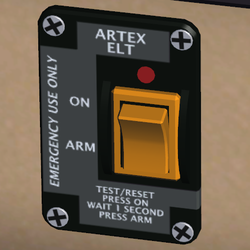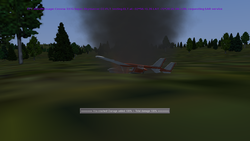Emergency Locator Transmitter
The ELT (acronym of Emergency Locator transmitter) is a device which send a message in case of aircraft crash. That message contains info about aircraft model, owner and approximate coordinates of the crashed plane, and it is made to request SAR (Search and Rescue) services.
Test
For testing the device proper function, just press the ELT button with your central mouse button (in most mouse models, the wheel). The red light will turn ON. Loose the button to stop the test.
Note: In real life, testing is permitted only in the first 5 Minutes of each hour, and there is also a maximum of three sent messages.
How it works
Many aircraft ELT have two basic ways to work: In a crash (The ELT will be activated automatically when hitting ground) and by pilot request (In case of emergency, the pilot may press the "armed" button in the remote control to send a emergency declaration message). In both ways, the device will send a message containing relevant information:
- Aircraft model
- Callsign
- GPS Coordinates
- SAR service request
Example: "ELT AutoMessage: Cessna 337G Skymaster FG-337 CRASHED AT -32*56 41.3S LAT -71*28 16.3W LON, REQUESTING SAR SERVICE"
For developers: Install an ELT in your aircraft
To download the ELT, just click here to get it. You will get a ZIP containing the required files, and a pdf document with the instructions to install and use it.
To install it, you just need first to copy the folder called ELT in your instruments directory, and put the remote (ArtexELT.xml) like any instrument in your panel. The second step is to link the nasal code in your aircraft-set file, just typing some like this:
<nasal> <ELT> <file>Aircraft/Your-Aircraft-Folder/Models/Instruments/ELT/ELTmessage.nas</file> </ELT> </nasal>
Be careful checking the right nasal file route. The code will get the aircraft model name and callsign for its own, so you don't need to modify it.

